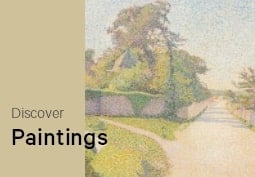Articles and features
Impressionism: The Movement That Went Against The French Art Academy
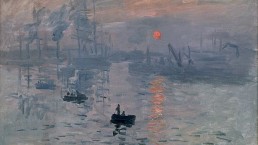
Impressionism definition: what is Impressionism?
By definition, Impressionism is a 19th-century avant-garde art movement that originated in France as a reaction against the established art of the French Academy and the government-sponsored annual exhibitions (Salons). The aim was to accurately portray visual impressions by painting scenes and subjects on the spot, using visible brushstrokes to record the changing qualities of light and movement. Today one of the most universally beloved art movements, selling for some of the highest prices, Impressionism was considered controversial and boundary-breaking in its time and artists like Monet, Degas and Renoir were shunned by the art establishment, causing quite a stir with their radical new style of painting.
Key dates: 1867-1886
Key regions: France, and later England.
Key words: anti-academy, painting en plein air, nature scenes, urban everyday life
Key artists: Claude Monet, Edgar Degas, Paul Cézanne, Pierre Auguste Renoir, Camille Pissarro, Alfred Sisley
The origins of Impressionism
Following the example of the ground-breaking 1863 Salon des Refusés, in the spring of 1874 a group of unacknowledged French painters, who at the time called themselves Le Societé Anonyme des Artistes and organised exhibitions that were not controlled by the reigning Paris Salon, organised an exhibition in the former studio space of one of their friends, the notorious photographer Nadar. The exhibition included works by Claude Monet, Pierre Auguste Renoir, Edgar Degas, Paul Cézanne, Camille Pissarro, Alfred Sisley and Berthe Morisot. Approximately 200 works were exhibited, and seen by about 4000 people. As the well-known story goes, art critic Louis Leroy gave a seething review of the exhibition, mockingly naming the group Impressionists, after Monet’s painting Impression: Sunrise which was particularly ridiculed by critics. “Impression—I was certain of it. I was just telling myself that, since I was impressed, there had to be some impression in it … and what freedom, what ease of workmanship! Wallpaper in its embryonic state is more finished than that seascape,” were the mocking words of Leroy.
The artists, however, co-opted the term and were from then on to be known as the Impressionists. The exhibition made history. This was the first time that Paris had witnessed a large-scale independent exhibition of avant-garde art, a direct challenge to the salon, the academic tradition’s historical subject matter and methods, and the official art world.
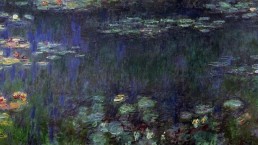
Key ideas behind Impressionism
The greatest difference between the style and method of the Impressionists compared to the art of the established Académie des Beaux-Arts was that these artists moved away from completely realistic depictions of historical subject matter. They were interested in nature and landscape scenes (one can think of Monet’s harbor views, seascapes and garden impressions), as well as urban everyday life scenes (think of Degas entering dance halls, opera houses and ballet classes to paint these everyday subjects then and there, or Renoir’s keen eye for Parisian leisure-seekers).
Preferring to work en plein air (in the open air) or on the spot, rather than in the studio, Impressionists found that they could better capture the fickle, ever-changing effects of sunlight, the transient effects of light and colour, and the essence of their subject matter, by painting quickly, with their subjects right in front of them. Their brushwork became rapid, more broken up into separate strokes and dabs so as to capture the fleeting quality of light.
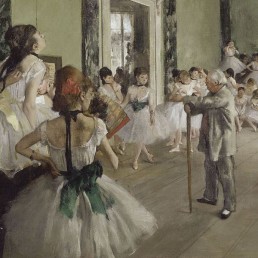
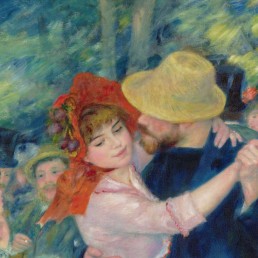
Famous Impressionists
Claude Monet (1840–1926)
Claude Monet is arguably the most famous of the Impressionists as well as the only one who continued to fervently paint nature scenes throughout his life. Monet’s early period also included many scenes from everyday modern life, but his main passion was depicting his radical, passionate view of nature. One could say this culminated in his most famous and beloved series, the Water Lilies. In 1893, Monet bought a strip of marshland across the road from his house in Giverny, where he cultivated a water lily garden. For the last 20 years of his life, this is where he pioneered a new type of spatiality in painting with that open composition in his paintings of his water lilies and Japanese bridge.
Monet’s large Water Lily cycle was offered to the French state by Monet himself as a symbol for peace after the armistice in 1918, and were hung in the Orangerie Museum in 1927, a few months after his death. André Masson described this as the “Sixtine of Impressionism”, referring to the Sistine Chapel. Besides the seminal Impression, Sunrise and the iconic Water Lilies, the artist’s mastrepieces include Le déjeuner sur l’herbe (1865–1866); Coquelicots, La promenade (Poppies), 1873; Woman with a Parasol – Madame Monet and Her Son, 1875; and Arrival of the Normandy Train, Gare Saint-Lazare, 1877.
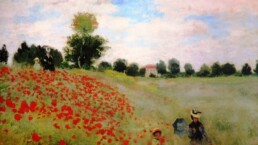
Edgar Degas (1834–1917)
Although he refused to qualify as an impressionist artist – preferring to call himself a ‘Realist’ or ‘Independent’ instead, Edgar Degas was one of the most emblematic artists of the Impressionist movement in France, only distinguished from other members from by his favour for inside settings illuminated by artificial light over plein-air landscapes. Born in Paris in 1834, he studied under Louis Lamothe – a former pupil of Jean-Auguste-Dominique Ingres – at the École des Beaux-Arts and his earlier paintings feature academic subjects and styles. It was only in 1865 that he changed course focusing his attention on scenes of modern life: from bustling cafès and theatres to horse racing and, most importantly, his iconic ballet dancers. Devoted to the study and realistic representation of movement, he found in dancers the ideal subject, eventually producing around 1,500 works in different media on the subject.
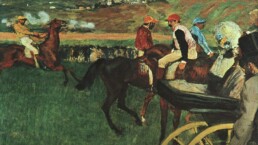
Camille Pissarro (1830–1903)
Often regarded as the “father of Impressionism,” Camille Pissarro was the only artist, along with Edgar Degas, to take part in all eight of the Impressionist exhibitions from 1874 to 1886.
He is known for his revelatory en-plein-airs depicting landscapes and urban French life, as he shared with the other Impressionists the desire to record the modern world by capturing the transient effects of light and colour with a specific focus on textures and chromatic values.
Although in his later life, his friends Paul Signac and Georges Seurat encouraged him to explore the techniques of Pointillism and Neo-Impressionism, after a time, he went back to working in the Impressionist style.
One of the movement’s most important core members, Pissarro held the group together encouraging and supporting other members, to the extent that art historian John Rewald called Pissarro the “dean of the Impressionist painters”, not only because he was the oldest of the group, but also “by virtue of his wisdom and his balanced, kind, and warmhearted personality.”
Among his most famous works stand out Two Women Chatting by the Sea, St. Thomas (1856); Road to Versailles at Louveciennes (1869); The Boulevard Montmartre at Night (1897); and The Boulevard Montmartre on a Winter Morning (1897).
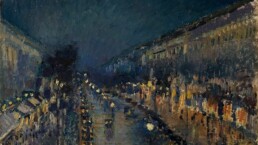
Reception and legacy
Seven further exhibitions followed at intervals until 1886 and the influence of Impressionism spread beyond France, especially in Britain.
By the mid-1880s, the group had started to dissolve, as each artist started to pursue their own principles and interests. However, Impressionism paved the way for many avant-garde experiences that followed, from Post-Impressionism and Neo-Impressionism to Fauvism and Cubism.
Post-Impressionists rejected Impressionism’s concern with a naturalistic rendering of light and colour, focused on more symbolic content, formal order, and structure, and believed in using colour as an expression of emotions and meaning. The main proponents of this movement were Van Gogh, Gauguin, Seurat, and former Impressionist artists Cézanne and Degas.
Neo-Impressionists like Georges Seurat, Paul Signac and their followers, on the other hand, were inspired by optical theory, ultimately abandoning the random spontaneity of Impressionism in favour of a measured, science-based painting technique.
Although initially greeted with derision, today Impressionism is widely-adored and is selling for some of the highest prices.
Written by Shira Wolfe
Relevant sources to learn more
Read more about Art Movements and Styles Throughout History here
Read the story of Mary Cassatt, a radical American Impressionist in Paris
